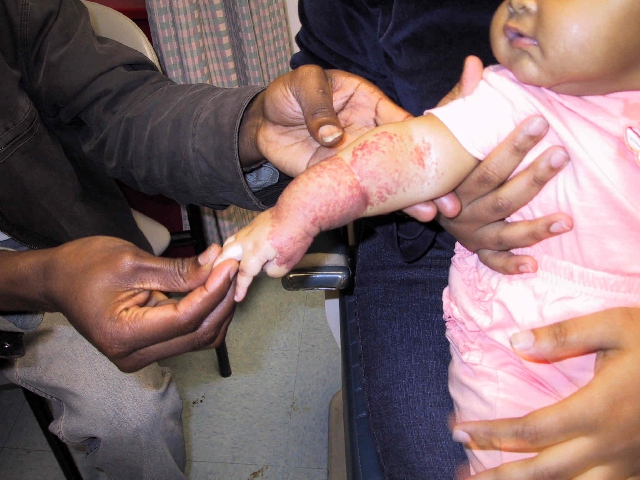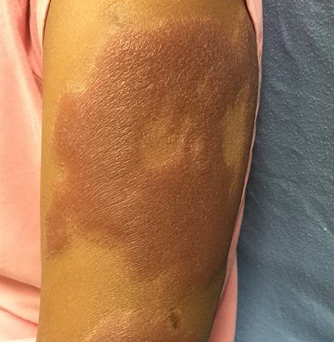CORRECT DIAGNOSIS:
Anaplastic Large Cell Lymphoma
DISCUSSION:
CD30+ T-cell lymphomas encompass a group of lymphoproliferative disorders that primarily include anaplastic large cell lymphoma (ALCL) variants, categorized into ALK-1 positive ALCL, ALK-1 negative ALCL, and breast implant-associated ALCL, which is recognized as a provisional entity. These lymphomas represent approximately 3% of adult non-Hodgkin lymphomas but account for a significantly higher proportion, around 10-20%, of pediatric lymphomas. The demographic most affected typically falls between the ages of 45 and 60, with a notable male predominance.
The ALK-1 positive ALCL subtype of CD30+ T-cell lymphoma is distinguished by the presence of the ALK-1 gene rearrangement, which is commonly associated with a more favorable prognosis. Patients with ALK-1 positive ALCL often exhibit variable genetic and clinical features. The 5-year survival rate for these patients is significantly high, ranging from 70% to 80%. ALK-1 negative ALCL subtype is typically observed in primary cutaneous cases, this variant tends to manifest as localized disease and generally carries a good prognosis. However, ALK-1 negative systemic ALCL presents a more challenging clinical scenario, with a poorer prognosis. The 5-year survival rate for this group is considerably lower, at 33% to 49%. Breast Implant-Associated ALCL is a newly recognized entity that has garnered attention due to its association with breast implants. While it shares characteristics with other forms of ALCL, its clinical context and unique presentation distinguish it as a separate category within CD30+ lymphomas.
Systemic ALCL is frequently characterized by “B symptoms,” which include fever, fatigue, weight loss, and night sweats. Patients may also exhibit respiratory symptoms such as cough and dyspnea due to mediastinal lymph node involvement. Furthermore, extralymphatic site involvement can occur in various organs, including bones, bone marrow, subcutaneous tissues, lungs, spleen, and liver
Diagnosis of CD30+ T-cell lymphomas is multifaceted, incorporating clinical evaluation, imaging studies, and histopathological examination. In our case, histopathological findings indicated a CD30+ lymphoproliferative disorder, favoring anaplastic large cell lymphoma (likely primary cutaneous ALCL) over lymphomatoid papulosis type C. This distinction is crucial for guiding treatment and management strategies, as the clinical and immunophenotypic profiles significantly influence the prognosis.
TREATMENT:
The treatment of CD30+ T-cell lymphomas, particularly anaplastic large cell lymphoma (ALCL), is tailored based on the specific subtype, disease stage, and the patient’s overall health. The primary treatment strategies for these lymphomas include chemotherapy, radiation therapy, surgical interventions, and in some cases, stem cell transplantation.
For ALK-1 positive ALCL, anthracycline-based chemotherapy remains the cornerstone of treatment. The most commonly utilized regimen is CHOP, which consists of cyclophosphamide, doxorubicin, vincristine, and prednisone. This regimen may also be complemented with targeted therapies such as brentuximab vedotin for patients with relapsed or refractory disease. In pediatric patients, the treatment protocol aligns closely with established B-cell lymphoma protocols, incorporating agents such as methotrexate, etoposide, and cytarabine to enhance efficacy against this aggressive lymphoma. For patients presenting with advanced disease, high-dose chemotherapy followed by autologous stem cell transplantation may be considered, especially in cases of relapse or adverse prognosis.
For ALK-1 negative ALCL, particularly in cases of primary cutaneous disease, treatment strategies can vary. Surgical intervention can be pursued for solitary lesions, which may offer a chance for complete cure. Radiation is frequently employed, especially for localized lesions. It has shown impressive response rates of nearly 100%. However, one analysis noted a recurrence rate of 1.7% after achieving a complete clinical response within seven months, highlighting the need for ongoing surveillance.
In our case, the patient was evaluated by hematology/oncology and underwent a PET scan, which revealed no evidence of extracutaneous involvement. Based on these findings, she was scheduled to receive superficial radiation therapy, guided by her hematology/oncology team. At her three-month follow-up, the patient demonstrated no new lesions, and local disease was not clinically detectable, suggesting a favorable response to treatment.
CONCLUSION:
CD30+ T-cell lymphomas, particularly anaplastic large cell lymphoma, encompass a diverse group of malignancies with varying clinical presentations and prognoses.The management of CD30+ T-cell lymphomas requires a comprehensive approach tailored to the specific lymphoma subtype and patient characteristics. While ALK-1 positive cases typically respond well to anthracycline-based chemotherapy and targeted therapies, ALK-1 negative and breast implant-associated ALCL may necessitate different strategies, including surgical excision and radiation therapy. The ongoing evaluation of treatment responses is crucial for optimizing patient outcomes and ensuring comprehensive care.
REFERENCES:
Connors, J. M., et al. (2018). Brentuximab vedotin combined with chemotherapy for stage III and IV anaplastic large-cell lymphoma: A phase II study. Journal of Clinical Oncology, 36(31), 3177-3185. https://doi.org/10.1200/JCO.2018.79.9203 [PMID: 30220953]
Hutchinson, C. B., & Mott, R. D. (2020). Anaplastic large cell lymphoma: A clinical and pathologic overview. American Journal of Clinical Pathology, 154(5), 668-676. https://doi.org/10.1093/ajcp/aqaa106 [PMID: 32926365]
Swerdlow, S. H., Campo, E., Harris, N. L., et al. (2016). WHO Classification of Tumours of Haematopoietic and Lymphoid Tissues. 4th ed. International Agency for Research on Cancer.
De Jong, D., Mollema, F. P., & van der Lee, J. (2021). Breast implant-associated anaplastic large cell lymphoma: A review. Current Oncology Reports, 23(4), 1-9. https://doi.org/10.1007/s11912-021-01062-3 [PMID: 33717234]




